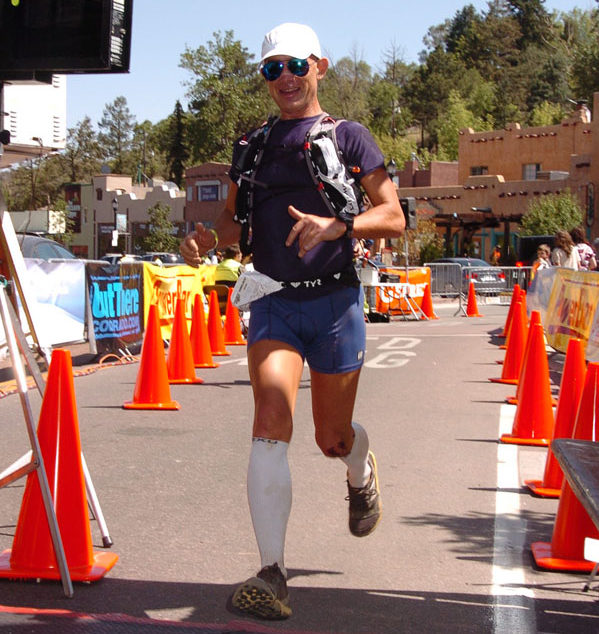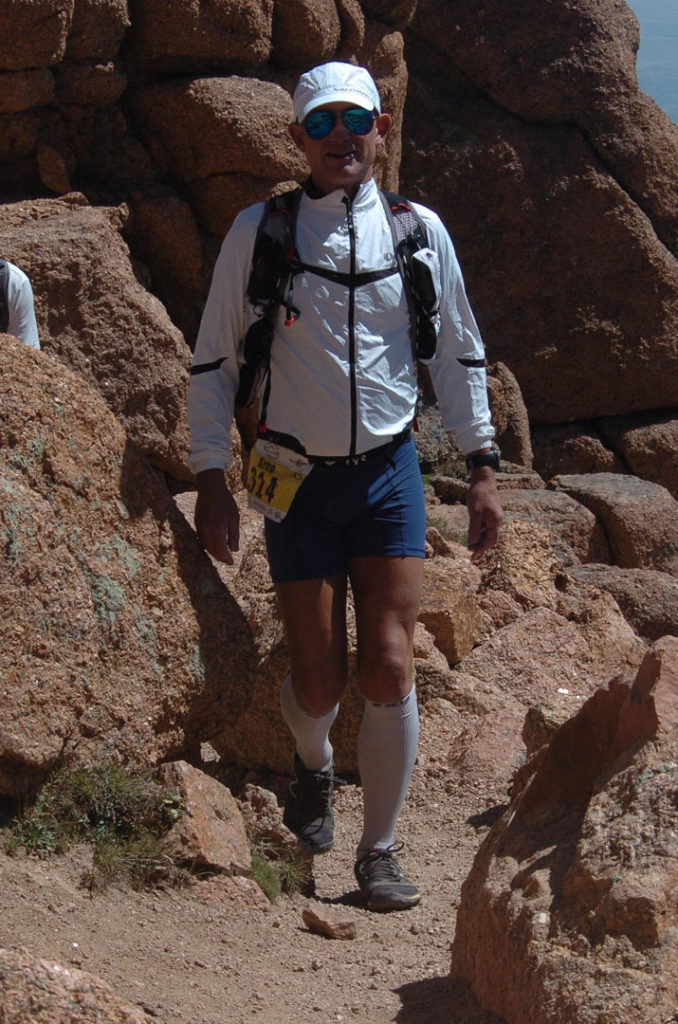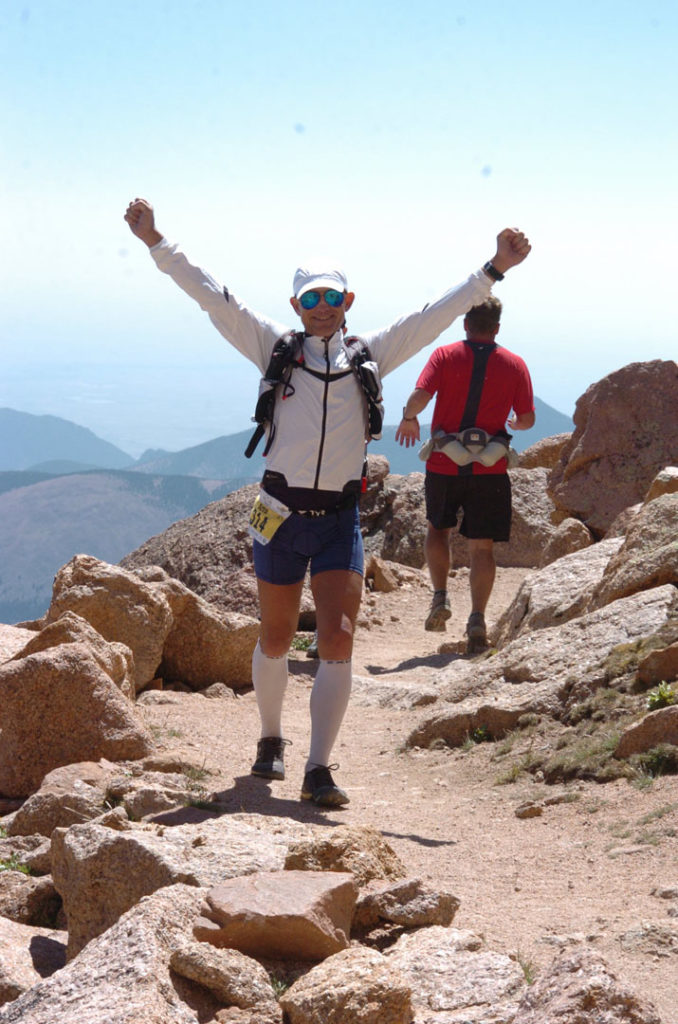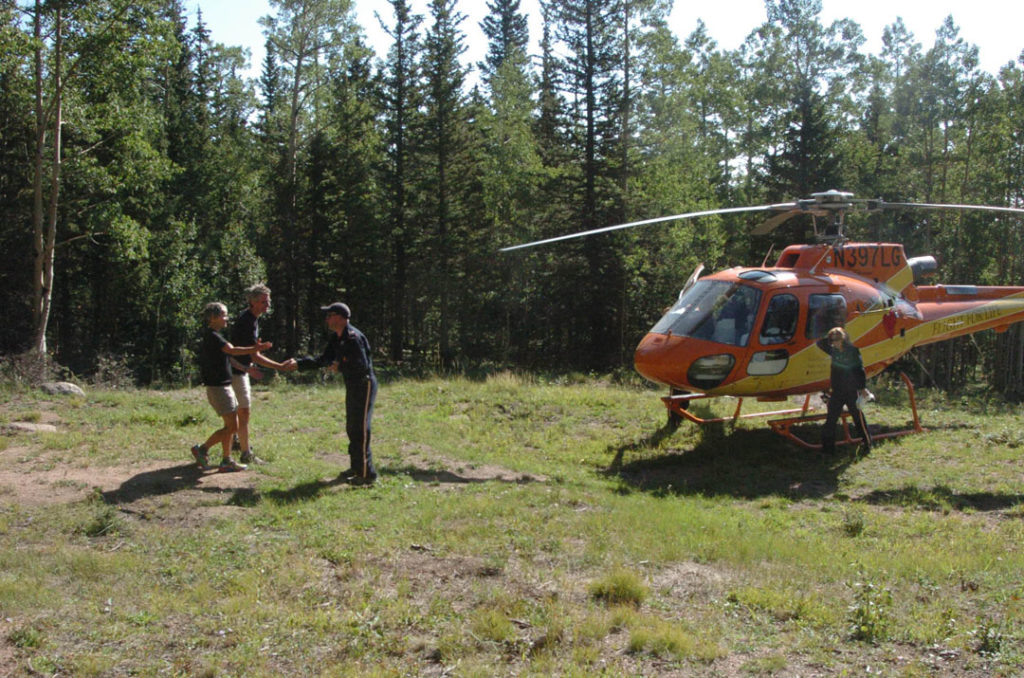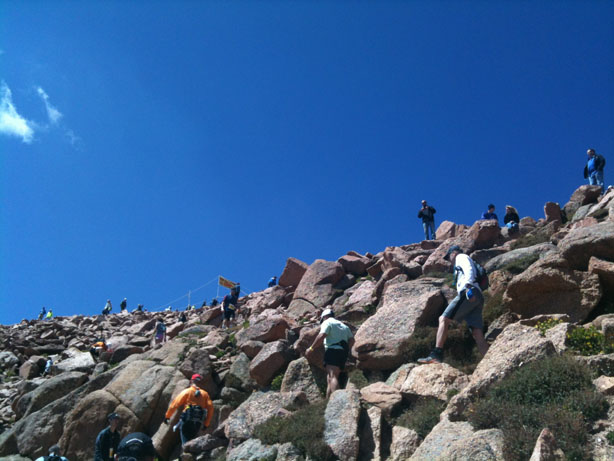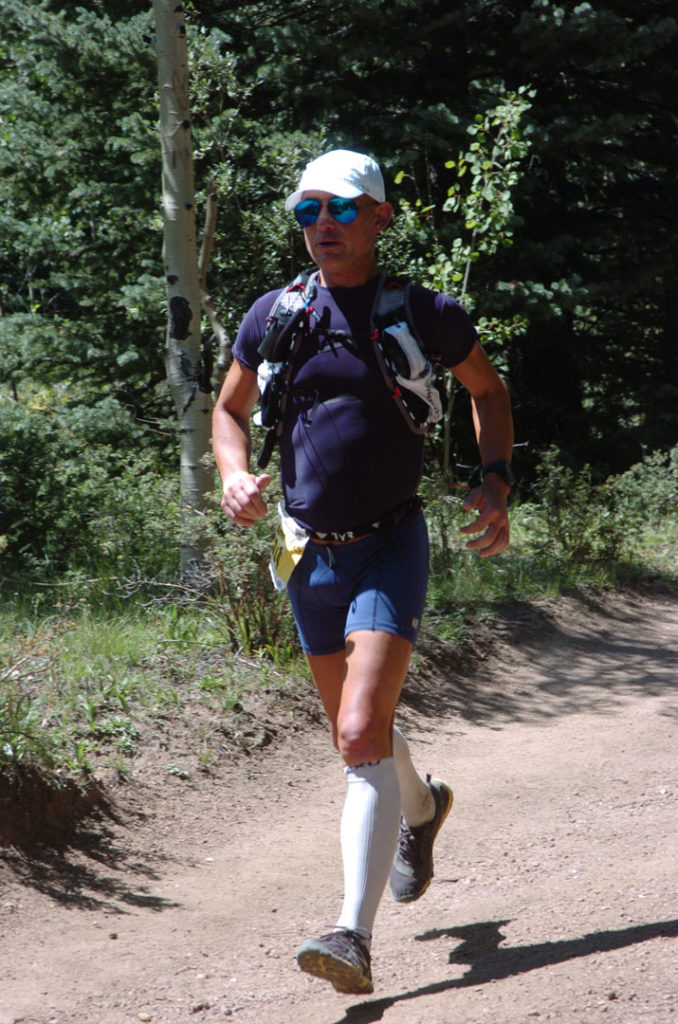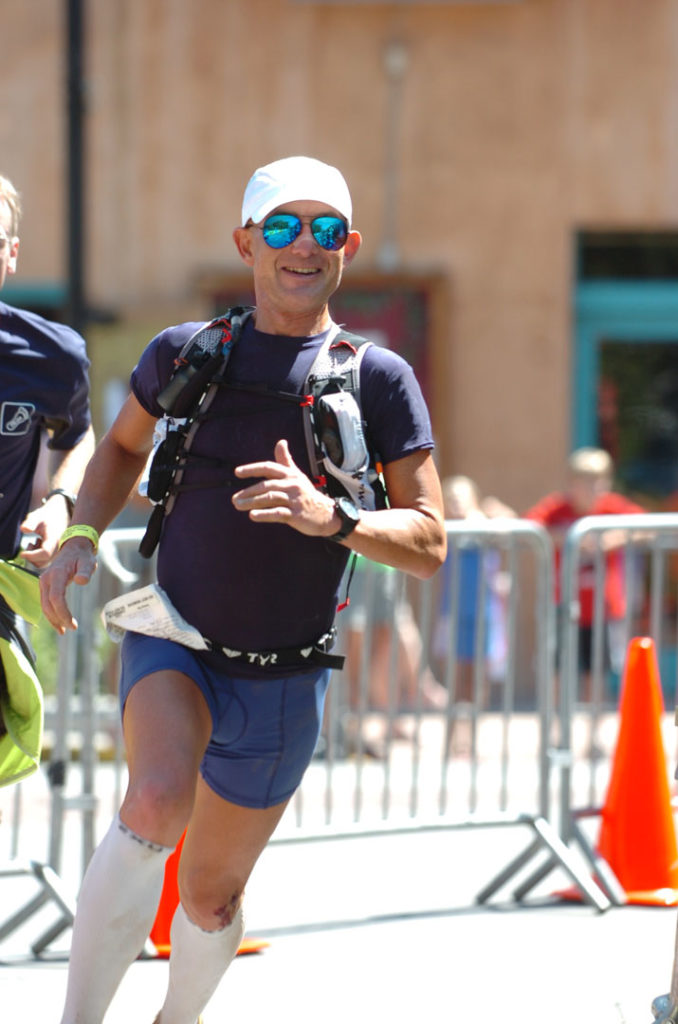
PIKES PEAK MARATHON
I have been wanting to run Pikes Peak Marathon since I heard about it which must have been for at least the last five years! The problem is that, unlike those road/city marathons where they will sign up 25,000 people or more, there are only limited slots at Pikes Peak (for the same reasons WS100, Miwok and all the cool trail races have a limited amount of spots: the park and forest service doesn’t let hordes of runners ruin the wilderness and it’s great that way).
Most limited edition races have lotteries but Pikes Peak doesn’t which means that one has to be clicking on the online registration when it opens and before the servers get congested. I have tried to register for Pikes Peak for 5 years and I never had any luck.
So on March 15 at 12pm PST I was at my desk – clicking, clicking, clicking. The first two attempts led me to an active.com overload page but I tried a third time and BINGO! I got in, paid my fee and all I had to do was show them that I was a sub 3:30 marathoner and I was in! Ecstatic! A dream come true! Pikes Peak here I come!
THE COURSE + THE CONDITIONS
The course is considered *challenging* although I didn’t find it so. Elevation gain (start to summit) is 7,815′ (2,382 meters); the start is at 6,300′ (1,920m) and the summit is 14,115′ (4,302m). The marathon turnaround is at approximately 14,050′. The average percent grade is 11%. So that is a steep 13.1mi (going down the same way) but nothing to agonize over. I was steaming with excitement over the downhill (I love running downhill and I’m also pretty fast… and reckless. It’s a lot like skiing).
Below are a couple of course maps and you can find more (including Google Earth flyovers) at skyrunning.com.
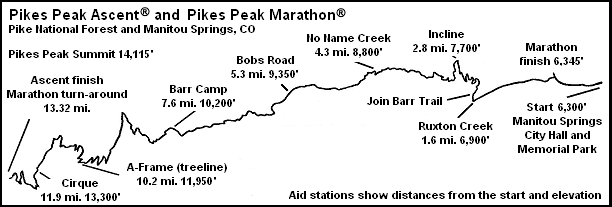

INTO THIN AIR
While I wasn’t nervous about the size of the mountain and the grade I was nervous about the conditions: altitude and weather. Regarding the altitude, although I have climbed pretty high I never ran that high. Over 10,000 ft there is much less oxygen in the air. The percentage of O2 stays the same in relation to other components in the air but the absolute quantity of O2 drops because the pressure drops. At 6,000′ the pressure is 620 mm Hg (that’s 18% less than at sea level) and at 14,115′ the pressure is 430 mm Hg (that’s 43% less than at sea level).
More or less and assuming temperature is constant this means that there’s 50% less oxygen at the top of Pikes Peak than in Los Angeles (ok there’s pollution in LA…). The figures are that at sea level there’s about 20% oxygen in the air and over 14000ft there’s 12% O2 in the air. The air is also extra dry at those altitudes.
I never experienced altitude sickness (other than peeing a lot – every time I’m above 10,000 ft/3000 m I pee a lot for a day or two. One of the body’s reactions to high altitude is water dumping to allow the blood to carry more oxygen. Frequent urination is a symptom of this process. But wait this leads to dehydration in an environment where the air is extra dry!
Yes, extra hydration is required to replace the lost fluids!). But when I go in altitude I don’t run I hike or climb. I arrived about 36 hours before the race and I stayed in Colorado Springs. Up until start time I thought I didn’t know I had so much fluid in me! I kept drinking water with electrolyte tablets added. That was all I could do!

WEATHER AND CONDITIONS
The second factor of pre-race anxiety was the weather which has been very unpredictable over the years during this event. There has been snow, lightning, wind. The race had to be canceled or shortened one year. Whatever I do I worry constantly over the weather – at sea, in the mountains, I know it’s the one thing that could get the most experienced person. So I pour obsessively over satellite maps, reports…
This year the forecast over Pikes Peak remained idyllic and it was idyllic. I don’t think we could have hoped for better weather. It was clear all the way with no wind, precipitation or late afternoon storms so common in alpine terrain in August. I had the gear just in case though, which was my pack and my jacket. I was just hoping there would be no cancellation since I felt particularly lucky to enter this year and had traveled all the way!
TRAINING
My training plan is embarrassing because I didn’t put more thought to it than running four days a week in the hills with periodization for the long run (that’s 3 days at 8 miles of hills and one day with mileage varying from 18 to 35 miles). I usually cycle as recovery the day after my long run and I swim for 1.25 hr on the other two days when I don’t run. Very simple training plan. And not to brag but I can run ultras on 4 days of running a week. For me running long distances is more of a lifestyle, something I do, like brushing my teeth or shaving.
However, training involves more than running miles. It also involves remaining healthy in body and mind and training the mind too! Two weeks before Pikes Peak I attended a conference for work and I caught a germ there. I was lucky it didn’t evolve into a pulmonary infection but it stayed until the race as a mild sinus infection, some sort of head cold. My nose was running all the time and if I didn’t clean the sinuses with salt water several times a day the infection would take hold.
Anyway by the time I made to the start line I had managed to get the rest I needed and I had pretty much stabilized all conditions. It’s really an art to getting everything ready and have the whole system ready to go for an event. Read the Miwok race report to see how everything before a race can end up messed up (mostly the sleep and the pre-race stress).
GEAR
Because Pikes Peak is a mountain race I decided to finally purchase my Salomon pack, the Advanced Skin S Lab 5. I was going to buy one for Miwok but I didn’t and then I saw my friend Andre’s pack and decided that yes it was something I really wanted because it’s awesome! I used it 2 or 3 times on hot long runs in Griffith Park and this is a great running companion, almost like a body extension.
Pockets are really accessible, it’s easy to refill, there’s no chafing, it’s really light and there are so many bells and whistles that it would need a review all on its own. I got a great deal at the I Run Far store. The pack is sold out at a lot of places and I could see a lot of runners whispering to each other while looking at me at the start line and I can only assume it was because of my running pack (or maybe I look like a complete idiot and that’s fine too!)
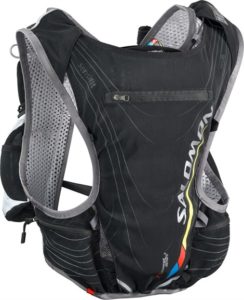
NUTRITION
And what to put in the pack? I didn’t expect the course to have much nice food (and I was right – they only had pretzels and M&Ms and some fruits – not bad but not optimal) so I packed 3 Pro bars (390 cal each), 2 Honey Stinger gels (120 cal each). Ahem, that’s only 1,410 cars… I know and I could have paid the price. For an event like this one should count at least 300 cal per hour so I should have packed 1,800 to 2100 calories. I got a couple of pretzels at some point but yes that’s all I hate during the event.
I had a huge breakfast (oatmeal, raspberries) and I ate a Probar and a banana before the start. So all in all that was probably 2,500 calories over 8 hours (it is within the range above). Since I didn’t bonk (I never do) the rest was fat burned. I also swallowed two Guayaki energy shots and each is 35 calories (and caffeine that doesn’t give the jitters).
OTHER STUFF
Also in the pack: Advil, Endurolyte capsules, credit card, cash, driver license, health insurance card, 500ml water, iPhone, arm warmers, a windbreaker, sunglasses, hat and vaseline (a good way to pack a small quantity is to fill a contact lens container with it). I found that the pack was quite heavy and I was freaking out. At the start line, there were guys with nothing. Just shorts and shoes… ok well maybe next time I run Pikes Peak barefoot wearing Speedos!
As for the shoes, I wore the same NB as for Miwok. I train in Vibram 5 fingers but I don’t like getting my toes stubbed so in events I want something a little more sturdy. I did also wear a pair of 2XU compression socks. On the course, I met some people wearing Vibrams five fingers and they definitely stubbed their toes a lot. Not really worth it.
THE EXPERIENCE
This was one of the best and most memorable marathons I ever ran! Probably as special as the first one, Boston or Amsterdam that I ran with my son.
I got up at 4:45 and after a good breakfast (instant oatmeal, raspberries, guayaki pure endurance tea, coffee) I was in my car toward Manitou Springs. The organization was great and I found a parking spot not too far from the start. I had about 30 min to warm up, stretch and stare at people. What I like about smaller races is that the atmosphere is much more mellow than the big city 25,000 people events. Manitou Springs is a charming little town and there really weren’t many people on the start line (549 males + 187 females finished). At the gun, we all started to run uphill on the road until we took to a single file trail. The temperature and atmosphere were already perfect.
I was a little concerned about cut-off times. I have to be because otherwise I would be stopping too often for pictures and chatting with nice people (see my last Silverman race – I think this served me a great lesson). I’m not racing anyone, I just want to have a good time in the mountains.
GOING UP
Not much to worry about though since I made it to Barr Camp at 9 am and the A-frame shelter at 10:05 or so. I was at the summit at noon.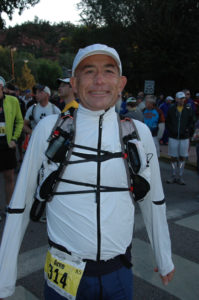
The climb was a lot of hiking eventually. Fast hiking. Sometimes the whole file would start running and I would just go along. Sometimes people in front of me started to pop up and deflate so I would pass them. After 11,000 ft I started to feel a little light-headed because of the altitude (what else could it be anyway – dehydration perhaps). I just paid more attention than usual to my breathing and I started to do pressure breathing which I usually do when mountaineering or ski mountaineering when there’s less oxygen.

I overheard a guy who was telling his friends that he got some Diamox and that he would share! He obtained it through an illegal prescription. I know it’s not really my business and I should let people have their own enjoyment of the event but I felt like telling the race officials on him! A part of me was a bit angry because it sounded like doping. Eventually, I went faster than him and I let it go… It was definitely the altitude that gave this marathon a distinct flavor, especially since I was coming from sea level. Apparently people who live in Colorado were at a little bit of an advantage on the way up but not so much on the way down.
KILIAN IS FAST
The first runner we saw going down was Kilian Jornet and it was amazing to see him run down. So fast! I have been a fan for some years so I really cheered him! Also, I was happy to get my picture taken with him at the award ceremony. Here is an interview with Kilian on the I Run Far blog. See what he says about the Pikes Peak trails being rather… boring!

At 12,000 ft it started to get a little cold so I put on my windbreaker. The last 2000 ft of climbing was fun. A beautiful rocky mountain, we could see the plains extending all the way to Kansas, the air was pure and clean and everyone was pretty happy. There were a couple of accidents (I saw a woman who was running down hit her head on a rock – ouch).
THE SUMMIT
The mountain rescue people were pretty much everywhere. It was a great moment to get to the summit. 14,115 feet! Yoohoo! I think it was my first fourteener in the US and part of a marathon! That’s pretty cool. I took a moment to enjoy the view and take it all in at the top.

While some more acclimatized runners might have passed me on the way up I think I passed over 100 people on the way down. I’m not sure why but I run downhill faster than average and also I enjoy it a lot! It takes so much mindfulness to not fall. In many ways, it’s a lot like skiing and the quads do a lot of work (see the cause of soreness below!). I did run behind another a runner for a while. She had the same pace and I think it saved me some terrain analysis energy.
WHAT GOES UP MUST COME DOWN
Tripped a couple of times (always because something or someone took my attention away) but I didn’t fall on the more technical parts of the trail. I did fall later running on a flat section (!) and I fell against just walking out of an aid station… and maybe one more time by the end of the trail…
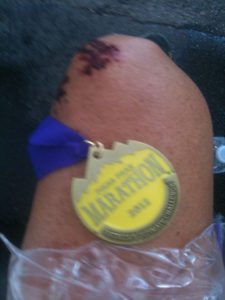
The last mile or so was back on the road and there I sprinted and passed more runners. I felt really good! I was happy with the accomplishment of running Pikes Peak and sad that it was over already.
THE FINISH
My time was 7:34 which is fine considering how many times I stopped to enjoy the view or snap pictures. I ended up in the middle of the pack and the middle of my age group. So I’m really happy with the result considering there were a lot of factors to manage. Would I do it again? If I’m the area and I can sign up that’s for sure. Otherwise, it’s a bit of a bucket list item as it gets quite pricey. Add up the flights, car rental, accommodations, etc. I do recommend it. It’s a great event with a top-notch organization and super volunteers at the aid stations.
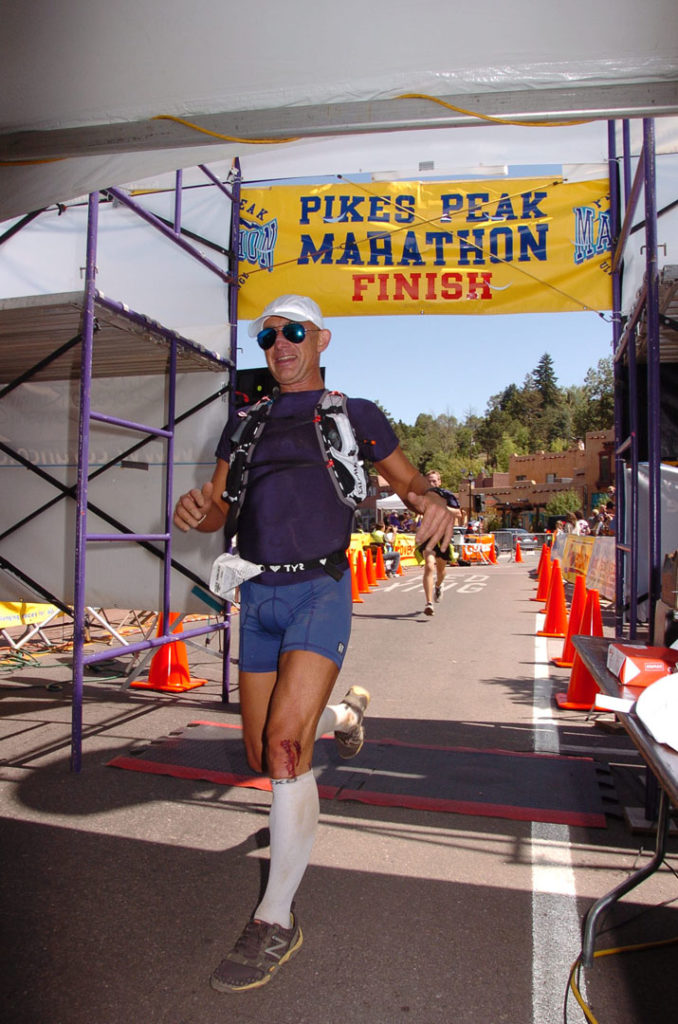
RECOVERY
I was a bit sore the next day and even more sore the day after. Probably from my wild descent. It took almost a week to repair! More soreness than Miwok actually. I didn’t run on the Monday after the race (I had to fly back to LA). On Tuesday I swam. The first run was on the Weds and that hurt a bit. It was a little hard to go upstairs but mostly to go downstairs which would indicate that I got sore from running wildly down the mountain! Totally worth it!
The Friday after the race I ran 18 mi of hills so I guess that signals a complete recovery. Now training is focused on my first 100 mi at Rio Del Lago on October 6. Here’s a photo album:
